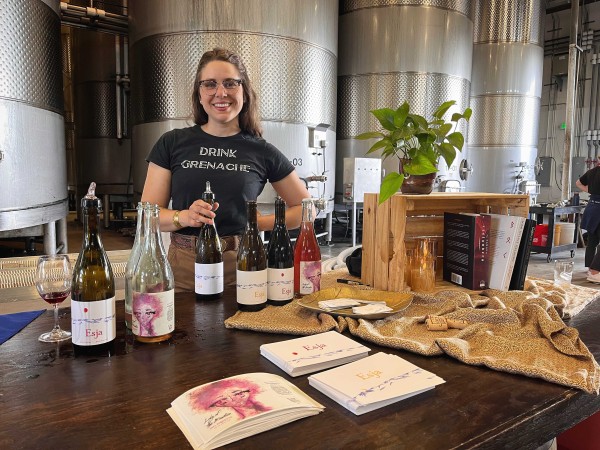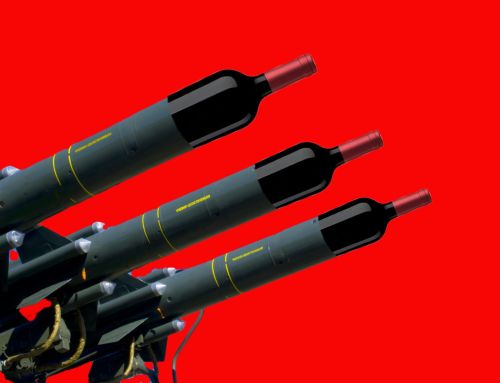 “Not every wine has to be big and jammy and bold,” says Esja owner and winemaker Tanya Bjornsson. “I think more and more people are leaning towards picking earlier.”
“Not every wine has to be big and jammy and bold,” says Esja owner and winemaker Tanya Bjornsson. “I think more and more people are leaning towards picking earlier.”
Indeed, Bjornsson and her Esja wines (pronounced Es-Ya) are part of a trend of wineries in Washington striving to make lighter-styled, lower-alcohol wines. For Bjornsson, arriving at that style was part of her wine journey.
Bjornsson’s mother was raised in Iceland, and her father was born there, where he worked as a commercial fisherman. In 1982, the couple moved to the Pacific Northwest to take advantage of the abundance of commercial fishing opportunities in the area.
Iceland might seem far away from the Pacific Northwest, but living in the Ferndale/Bellingham area of Washington, Bjornsson’s family was friends with plenty of fellow Icelanders.
“We called it the Icelandic mafia,” laughs Bjornsson, who was born in Seattle and has dual citizenship with Iceland. “There’s a huge Icelandic population here.”
Bjornsson became interested in wine earlier than most, as a teenager. Her brother-in-law was studying to be a sommelier and occasionally let her try wines he was tasting.
“That was the first time that I realized you could have wine as a career,” Bjornsson says. Interested, she took sommelier classes at South Seattle Community College in 2015.
After attending Western Washington University in Bellingham and graduating with a degree in French, Bjornsson moved to Portland, Oregon with the intent of entering the restaurant industry. There was just one problem. She had no experience.
“I got rejected everywhere,” she says.
Desperately in search of work, she applied for jobs all over the state. She was ultimately hired as a harvest intern at Union Wine Company in Tualatin in 2015. Union is best known for its canned wines, though the winery makes wines in traditional packages as well.
Once harvest was over, the interns were summarily dismissed. Bjornsson, however, kept coming to work.
“They clearly needed some extra help, and so I just kept showing up,” she says. “After a while, they’re like ‘Well, she’s not leaving.’” Bjornsson was eventually hired full-time at the winery.
Bjornsson’s internship and then full-time work at Union Wine Co. were on-the-job training in winemaking. The company was growing by leaps and bounds, harvesting 1,000 additional tons of fruit each year she was there.
Union hires a staggering 30 interns each harvest, selecting people from all over the world. For Bjornsson, this group provided an opportunity to learn, to teach, and to make valuable connections.
One such connection convinced Bjornsson to work harvest at Greystone Wines in Waipara, New Zealand. In 2018, she travelled there.
That same year, Greystone winemaker Dom Maxwell was named New Zealand’s winemaker of the year by Gourmet Traveller. Though it was a prestigious accolade, Maxwell took a humble approach with his interns.
“He would ask us questions and really take our opinions into account,” Bjornsson says. “I realized I needed to start figuring out what I like and my style of winemaking.”
After spending three months working harvest, she received word that her husband accepted a job in Seattle. The couple moved to the city shortly thereafter, with Bjornsson taking a harvest internship at EFESTE in Woodinville.
Going from Oregon to New Zealand to Washington was quite a stylistic shift. “My palate was all shocked,” she says. “They were some big, bold wines.”
It was also a steep learning curve working with different varieties from a different region made in a different style. It also, however, helped Bjornsson further understand what types of wines she prefers.
“I tended to lean towards the lighter-bodied wines,” Bjornsson says.
Once harvest wrapped up, she was hired at nearby Darby Winery as assistant winemaker. At Union, Bjornsson had helped process 7,000 tons of fruit. Now she was processing 60-70 tons, though without an army of interns at her side.
 In 2020, Bjornsson made her first wines for herself, leveraging contracts that Darby had, making Grenache and Roussanne from Stillwater Creek on the Royal Slope. She made a scant 75 cases of each. She made the same the following year. In 2022, she increased production to 700 cases, including new fruit sources in the Rattlesnake Hills appellation and adding Cabernet Franc and other varieties to the portfolio.
In 2020, Bjornsson made her first wines for herself, leveraging contracts that Darby had, making Grenache and Roussanne from Stillwater Creek on the Royal Slope. She made a scant 75 cases of each. She made the same the following year. In 2022, she increased production to 700 cases, including new fruit sources in the Rattlesnake Hills appellation and adding Cabernet Franc and other varieties to the portfolio.
“I like to pick [fruit] early,” Bjornsson says of her approach. “I like to retain acidity. I want light-bodied, acid-driven, delicate wines.”
Overall, she describes her approach to winemaking as “simple.”
“Most of the time for reds, I let the grapes ferment wild. I press them to tank, let them settle out, put them into neutral oak barrels to ferment, rack them again into tank, and then bottle. I’m trying to keep everything fresh and keep the acidity.”
Bjornsson named her winery Esja after a 2,999-foot tall peak in Iceland. “When you’re in Reykjavik, you see [the mountain] from everywhere,” she says. “The mountains are beautiful but unassuming. For me, it was like an ode to being a woman in the wine industry. Most people wouldn’t pin me as a winemaker.”
With lighter-styled wines becoming increasingly popular with some winemakers and consumers in Washington, the Esja wines have been well-received. The first restaurant Bjornsson pitched her wines to was the legendary The Herbfarm in Woodinville.
“I was terrified,” she says. The wines have subsequently been poured at a number of dinners at the restaurant.
Local distributor Cru Selections picked up the wines as well, no small feat for a new winery. Numerous local retail shops also carry the Esja wines, which are currently sold only through the website or distribution.
Bjornsson left Darby earlier this year to focus on her winery full-time. Overall, she says her goal with Esja is as simple as how she makes the wines.
“I want to make light-bodied wines that are unassuming, fun wines. I’m not trying to be the best in the world. I just want people to enjoy fun wines.”
Read reviews of recent Esja wines here.
Images courtesy of Esja.







Leave A Comment